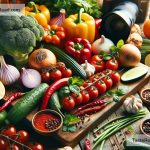How to Take Stunning Food Photos for Travel Blogs and Culinary Tourism
Travel and food are two elements that blend perfectly together. They both have the power to tell stories, evoke emotions, and create lasting memories. For travel blogs and culinary tourism platforms, captivating food photos can significantly enhance the appeal of the content. If you’re keen on making your travel blog stand out or want to delve into the world of culinary tourism, mastering the art of food photography is essential. In this post, we’ll walk through simple and effective tips for taking food photos that will make your audience’s mouth water.
1. Light is Your Best Friend
The first and perhaps most crucial tip for taking amazing food photos is to make use of natural light. Soft, natural light can make the colors of the food pop and give your photos a much more appealing look. Avoid using your flash as it can create harsh shadows and alter the natural colors of the food. If you’re dining indoors, try to sit near a window. For outdoor photography, early morning or late afternoon when the light is softer can provide stunning results.
2. The Power of the Background
While the focus should be on the food, don’t underestimate the importance of a good background. A cluttered or unsightly background can distract from the star of the show. Simplicity is key. Use plain backgrounds or textures that complement the food without overshadowing it. Wooden tables, marble slabs, or even a simple, clean plate can serve as effective backdrops.
3. Composition is Key
How you arrange the elements in your photo can dramatically affect its impact. Play around with different angles and compositions to find the most appealing setup. Top-down shots work great for dishes served on plates or bowls, showcasing the arrangement and variety of the meal. Side angles can highlight the textures and layers of foods like burgers, cakes, or layered drinks. Remember, the rule of thirds can be your guide; positioning the primary elements off-center can make the composition more dynamic and engaging.
4. The Devil’s in the Details
Capturing the details of the food can take your photos from good to great. Zoom in to show the texture of the crust, the juiciness of the fruit, or the gooeyness of the cheese. These details can convey the flavor and quality of the food better than any description can. However, be wary of going too close and losing the context of the dish.
5. Color and Contrast
One of the joys of food photography is the vast array of colors you get to work with. Playing with color contrast can make your photos more vibrant and eye-catching. A slice of bright red tomato on a green salad, a sprinkle of fresh herbs on a creamy pasta dish, or a colorful cocktail against a neutral background can create a focal point and enhance the visual appeal of your photo.
6. Keep it Real
While you want your food photos to look as appetizing as possible, it’s important to keep them realistic. Over-styling can make the food look artificial and unapproachable. Sometimes, a little messiness can add to the authenticity of the shot. A drizzle of sauce, a spoonful taken out of a dish, or crumbs scattered around can add life and movement to your photos.
7. Edit Wisely
Post-processing can be a powerful tool in food photography, but it’s vital to use it sparingly. Adjusting the brightness, contrast, and saturation can help your photos pop, but avoid overediting as it can make the food look unnatural. There are several photo editing apps and software designed specifically for food photography, offering presets that enhance the food’s appeal without going overboard.
8. Practice and Experiment
Finally, the best way to improve your food photography is to practice consistently. Experiment with different dishes, settings, and techniques. Each food item presents its unique challenges and opportunities for creative shots. The more you practice, the better you’ll become at spotting and capturing those mouth-watering moments.
Capturing stunning food photos for your travel blog or culinary tourism platform doesn’t require professional equipment or advanced skills. With these simple tips, you can significantly enhance the appeal of your content, making it irresistible for anyone who comes across it. Remember, food photography is as much about passion and creativity as it is about technique. So, wield your camera with love, and let your culinary adventures unfold through your lens.



Keep up the fantastic work and continue to inspire us all!
Your words are powerful and have the ability to make a real difference in people’s lives Keep using your voice to spread positivity and knowledge
Your positive and uplifting words are like a ray of sunshine on a cloudy day Thank you for spreading light and positivity in the world
I love how you incorporate personal stories and experiences into your posts It makes your content relatable and authentic